Introduction
Book I “The Book of Fog” and Book VII “The Book of Names”: Reconstructing the World in Rohatyn
Space: Interconnected Places
Spiritual Dimension: Heaven and a Tower of Babel
The Destruction of Rohatyn: Circulation of Times
Book II “The Book of Sand”: “You are just at the beginning of the road now”
Goods and Economic Exchanges: “Overlapping panthers, squiggles, tangles, trails.”
Religious and Political Journey: “Being a great sinner”
The path of Languages: “You are just at the beginning of the road now”
Book III “The Book of the Road”: Challenging Women Empowerment
Female Empowerment and Disempowerment
Rethinking Color Stereotypes
Tracing Jacob’s Journey
Imagining Otherness
Book IV “The Book of the Comet”: Under Jacob’s Watchful Eye
Comet’s Divine Meaning
Conceptualizing Frank’s Perspective
Book V “The Book of Metal and Sulphur”: Bathed in Light
Representing Jacob’s Enclosure
Using Color, Illustrating Emotions
Circulation of Letters, Ideas and People
Symbolizing the Outside World: Sefirot Tree as a Landscape
Being Yente
Conclusion
Book VI “The Book of the Distant Country”: Rotating Circulations of Religion, Power, Social Stratification and… Love.
Marriage: A Nexus between Social Strata
A Vinyl: The Spinning Cycle of Life
Intersecting Memories
Symbolizing Colors of Celebration
Introduction*
How can I engage students in the circulation of ideas, teaching them about the people and topics that comprise the Central and Eastern European Jewish worlds? How can I present the complexity of this social universe, avoiding the simplistic stereotypes of folklore? How can I diverge from the beaten track, proposing a more collaborative pedagogical approach, filled with dialogue and creativity? These were all questions I asked myself in 2024 as I prepared a new course at Sciences Po Paris on Central and Eastern European Jewish history and culture. This course would be taught in English both to regularly-enrolled Sciences Po students as well as exchange students from foreign countries. In fact, my students come from highly varied backgrounds: France, the US, Singapore, Japan, Canada, Great Britain, Ukraine and Spain. Many of them identify as being Jewish themselves and seek to learn more about “their origins.”
Preparing this course also coincided with my work towards publishing a book about creative practices in research,1itself inspired by my pedagogical experience of introducing creative activities in the classroom: in a different class I teach on political memory, I had my students explore the topic by making comic strips.2
At the same time, I was also asked to write an article on Olga Tokarczuk’s novel The Books of Jacob.3 The length of the work (over one thousand pages) and the complexity of its narration put me off, so for quite a while the book lay on my bedside table, a reminder of my regret… Finally, I decided to put two and two together and use it for my new class. Turning the novel into required reading finally forced me to read it. In the end, despite how hard it was to read, page by page I fell in love with the book. It turned out indeed to be a particularly rich source for pedagogical inspiration.
It must be said that the novel in question was particularly appropriate for the course I planned to teach. Tokarczuk’s work allows the instructor to explore Central and Eastern European Jewish history during the whole of the modern period (early and late). In particular, it focuses on the story of Jacob Frank, an eighteenth-century Jewish mystic and heretic. Born in Podolia in 1726, he studied Kabbalah before joining the movement of Sabbatai Zevi, another Jewish mystic and heretic from the previous century. Both mystics declared themselves to be Jewish messiahs; Frank claimed to be Zevi’s reincarnation. While Zevi ultimately converted to Islam, Frank converted to Catholicism. The Polish-Lithuanian Commonwealth at the time was also ripe for their proselytizing efforts. At the time, the Commonwealth of the Two Nations was undergoing major economic, social and political changes. As has so often happened in such historical moments, Jews were blamed for everything that went wrong. They faced blood libel and host desecration allegations, hideous medieval calumnies. Pogroms then followed. Jacob Frank’s spiritual moment was a response to this crisis, just as Sabbatai Zevi’s movement was seen in response to the pogroms which accompanied the Zaporozhian Cossacks’ uprising led by Khmelnytsky in 1648. Frank and his followers were excommunicated from the wider Jewish community, put under herem for rejecting the teachings of the Talmud. They were, however, supported by Bishop Dembowski and by a group of Polish nobles who saw them as rife for conversion to Christianity. Despite that fact, after his baptism Jacob was imprisoned in the Pauline Monastery of Jasna Góra—known as the home of one of the most famous Polish icons, the Black Madonna, which has also come to be seen as a symbol of Poland. Freed by the Russian army, who were making war on the Polish-Lithuanian Commonwealth at the time, Frank and his disciples fled to Brno, then to Offenbach, near Frankfurt am Main. After Frank’s death, his daughter Ewa took the reins of his movement, which then petered out following her own death.
While the movement may have ended, nonetheless, Frank’s beliefs have, to some extent, survived long past him. His project was not, after all, solely a spiritual one. He aimed for a social revolution. In fact, some of his disciples experienced a major change in their social circumstances: from a low social and ethnoreligious status, they rose to the ranks of the aristocracy. Mentored and supported by certain Polish aristocratic families following their baptisms, they adopted Polish Catholic names and took on prestigious jobs in Warsaw, the Commonwealth’s capital. Frank’s teaching also engendered a moral revolution, encouraging free love (although Frank’s sexual politics remained male-dominated). Frank’s revolutionary mindset was in the context of a belief that the world was ending. Spiritually speaking, the pogroms were a sign of this, as was a comet seen in 1759. Socially, “Frankism” responded to the new outlook of the Enlightenment, demanding equal rights for all, including Jews. Certain scholars, such as Gerschom Scholem, affirm that—in destroying the previous rabbinic order—Frankism paved the way for the coming Haskalah, the movement of Jewish modernization and secularization which took place between the mid eighteenth to late nineteenth centuries. Despite the numerous contradictions in his theology and his actions, which were often calculated on making a profit, Frank was a unique leader of messianic currents within Judaism, alongside Sabbatai Zevi and Baruchja Ruso. Through his story, the reader can thus trace that of a certain philosophical and social trend throughout Europe.
Frank’s story is also that of a Jewish topography, connected to the wider world. From page to page, Tokarczuk’s historical novel introduces us to hamlets, villages, cities and entire regions filled with Christians, Jews, and Muslims, people who speak multiple languages and who are all inter-connected. Here, we are far from the fixed visions of schtetlech—Jewish villages lost in time on the old maps of Eastern Europe, closed in on themselves and seen as autarkic. Tokarczuk’s Jews trade, travel, marry, and thus move frequently. They also flee persecution and pogroms. With them, they take their goods to sell, their languages, their spiritual beliefs and their ideas. In reading this book, I began to see nearly infinite connections and patterns of circulation that I could share with my students.
And it was precisely this idea of an intimate topography of the Jewish world—of plural topographies—that I wanted my students to engage with pedagogically. I asked them to create a creative cartography. I split my students up into six groups, each of which had to read one of the “books” making up Tokarczuk’s work, except for a final group which read the comparatively-shorter first and final “books” together. Each group thus had to read between 150 and 200 pages of the historical novel, pulling out one or more quotes which they found particularly representative of the wider work, and translate these into creative cartography.
But what, in fact, is creative cartography? While traditional maps are based on physical or administrative landmarks such as buildings, roadways, waterways, place names and borders, creative cartographies are a different way to understand space. They focus on spatial referents which are important or meaningful to an individual or to a group of people. Their object is to reconstitute the way in which these people live, perceive, and occupy their space. This does not mean, however, that traditional representation has no place on this type of map. In other words, it is a question of spatially transcribing qualitative material (such as emotions, affects, memories, lived accounts, mental images, sounds, smells, etc.). Representing space in this way will thus differ depending on the people in question, their personalities and their stories. As a practice, it is particularly well-adapted to depicting micro-spaces or micronarratives. Creative cartography—or creative mapping—can also be used to depict a historical phenomenon and to juxtapose the varied experiences of many different people. In the context of my course, creative cartography allowed me and my students to focus on and unpack the perspectives of Jacob Frank and of his disciples.
I left my instructions deliberately vague. Based on a shorter or longer representative excerpt of a part of the “book” which focused on a microhistory or a microevent (a biographical narrative, a geographical genealogy, a travel itinerary, troop movement on a battlefield or even the blueprints for a house), my students had to create a map, as well as to write a text to accompany it so that the map could be read and understood (as creative cartographies are rarely understandable on their own). They had to explain their choice of representative excerpt in an academic and objective style and they had to describe their map and its legend. My students accompanied their work with an oral presentation on their choice of subject: why did they choose a specific quote over others? Why did they choose to focus on that specific historical phenomenon, story, or biographical narrative? They also had to present their creative process: what discussions did they have before making certain creative choices? How did their map, once initially conceived, get made and re-worked? Why did they choose to make it using one type of material rather than another? Finally, they had to explain their map’s legend. How can we read their map? Why did they choose to present their information as they did?
My students were allowed to use all kinds of materials to depict the narratives, emotions, subjectivities and space: however, this freedom required inventiveness and imagination. The choice could not be simply a practical one; it had to involve reflection. My goal was to lead my students to consciously consider the process of creating their maps, both in what kind of information these would include: interviews, photographs, drawings, literature, poetry, or archival materials; the way that these give rise to emotions, feelings and thoughts; and the materials they would use to depict these: fabric, collage, drawing, etc., as well as the way they would mix all of these themes, concepts, ideas and tools together. Their maps could be multidimensional, in 2- or 3D. They were even allowed to use AI, but had to use it as an epistemological contribution towards building their map. And so, this type of work, depicting academic knowledge via artistic creation requires not only academic rigor but also inventiveness and imagination.
The work which resulted from these guidelines, bears witness to the great investment in time and energy that my students put into their task. They read and re-read long sections of the book—some read the novel in its entirety. Despite what is often said to the contrary, students are both capable and eager to read long, historical and complicated texts. Their work also displayed great levels of reflection and consideration in building their maps: their use of materials, their choice of quotes, and the way they put them together showed both their academic understanding and the way which they made Tokarczuk’s work their own. For my own part, I can attest to the conscious intellectual consideration of my students at every stage of creating these hybrid objects. The work also allowed my students to get truly involved in the course, spurring discussions which often went beyond classroom hours. The historical content I taught resonated well with the novel’s content, allowing me and my students to move seamlessly between historical source texts and the novel itself, nourishing conversations on choices made by historical figures and placing these within their socio-historical contexts.
Teaching and transmitting knowledge through art and creative processes is one way of using academic thought “in another way.” We must recognize that art functions according to its own logics and that we can perceive the world in different ways, via different formats and means, often far removed from the practices of traditional academia. This type of pedagogy offers a new intellectual approach which both students and teachers can benefit from. Multiple experiments in both social science and the humanities as well as in the hard sciences4 show that this approach is promising. We can take inspiration from this and use these tools to diversify the relationships between academic disciplines, which are too often siloed away from one another, and the arts.
back
Book I “The Book of Fog” and Book VII “The Book of Names”: Reconstructing the World in Rohatyn
Leo Brown (McGill University/Sciences Po Paris), and Bradley Brown (University of California Santa Barbara/Sciences Po Paris).
Our map treats the first and the last books of Olga Tokarczuk’s novel, respectively “The Book of Fog” and “The Book of Names.” The first one reveals an interconnected world that does not escape antagonisms: that of nobles traveling between their numerous estates, village priests, and Jewish merchants inclined towards Kabbalah. The last one closes the novel: we discover the death, one by one, of Jacob’s fellows, the aftermath of the Frankist adventure in Offenbach, the legacy left by all those who participated in it.
It is a representation of the world, including the continents of Europe, Asia, and North America, with the village of Rohatyn, a point of historical and geographical importance at the center. It is in Rohatyn that most of the characters are discovered: Father Benedykt Chmielowski, priest of Firley and dean of Rohatyn; the noble Katarzyna Kossakowska, born Potocka, palatine of Kamieniec, who travels with an elderly lady, Ms Drużbacka; Elisha Shorr, descendant of Rabbi Zalman Naftali Shorr, a Kabbalist and Sabbatean; his daughter Haya, who will play a prominent role among the Frankists, and her brother Izaak, whose imminent marriage brings together the entire extended family; finally, Iente, the eldest of the family, who, through a magical twist, finds herself between life and death and will observe the world from above throughout the novel.
There are three elements that we are representing in our creative cartography: the vastness of physical space that Rohatyn represents, the spiritual dimension of Rohatyn, and the destruction of Rohatyn and its rebirth in Canada. All these elements are meant to represent the interconnected space, time, languages, and spiritual realms that are packed into Tokarczuk’s representation of a small village in eighteenth-century Poland—which has an unexpected level of globalization that rivals even modern times.
back
Space: Interconnected Places
The map is meant to be read right to left, in the same way Hebrew and Yiddish are read. This direction was chosen because Yiddish is the colloquial tongue used by the main characters of the story and Tokarczuk’s pagination of the book was in reverse order, so we thought it would be consistent with Tokarczuk’s style to read the map in reverse order from English. The map begins on the Asian subcontinent, showing the regions of modern-day China and India. This is inspired by a quote from Book One: “They sell garlic, herbs, pots full of spices, canisters and jars containing so many seasonings, crushed, ground, or in their original form, like these vanilla pods and nutmegs and cloves. On the shelves, there are bolts of cloth arranged over hay – these look like silk.”5 Cloves and silk were produced in China and India, which is why we wanted to figure these areas on the map to show how Rohatyn is interconnected with these places. We chose to write out the word “cloves” in Chinese characters to depict a language that is interconnected with Rohatyn. Finally, these goods must have been transported to Rohatyn, which is why we added a caravan to show the goods being transported. This also provided continuity to allow the viewer’s gaze to move to the next section of the map.
In the center of our cartography is the continent of Europe, with a map of Rohatyn at the center. This section was inspired by a quote from Book One:
First she tries some women holding baskets, but they giggle and run away, speaking Ruthenian, so then she tugs at the sleeve of a Jew in a hat and coat —he tries to understand her and even responds with something in his language, pointing further down towards the river. Then, having lost the last of her patience [...] “Does anyone here speak Polish?” she finally screams.6
We attempted to visually represent this quote by showing Rohatyn’s interconnectedness with Europe, with the map of Rohatyn directly on top of the rest of Europe. We also illustrated the linguistic diversity of Rohatyn by writing directly onto the map some of the languages that were spoken in Book One, in this instance Yiddish, Hebrew and Polish.
Finally, the map ends with a map of modern-day Canada. This is inspired by a quote from Book Seven: “They have all survived, and in the postwar chaos, most of them manage to emigrate to Canada, where they tell their story, so improbable that few believe them.”7 This final part of the map represents the endpoint of our creative cartography. After the destruction of Jewish civilization and Eastern Europe during World War II, life—especially for the Jewish community—was transplanted to new places such as Canada. This part of the map attempts to represent this. In addition, it is a passage of time since this transplantation takes place after World War II. Thus, this aspect of the creative cartography shows how Tokarczuk included multiple layers of time in her story.
back
Spiritual Dimension: Heaven and a Tower of Babel
Apart from the depictions of Asia, Europe, and North America, our creative cartography also maps the spiritual dimensions present in Book One. This is inspired by the quote: “‘The rabbi is listening to the voices of his elders’.”8 We viewed it as essential to include in our map because views of heaven and spirituality were as tangible to the characters of the story as continents and landforms—to the extent that people could communicate with those dimensions. To draw the reader’s eye up towards heaven, we used an illustration of the tower of Babel. This choice was guided by the fact that the tower is frequently mentioned in the first Book, which is a universal story that is believed by both Christians, such as Chmielowski, and Jews such as Rabbi Shorr. Above the tower, we decided to depict a view of heaven with Hebrew characters. We chose this because it is almost impossible to find illustrations of Heaven in the Jewish tradition. The words in Hebrew we wrote were שָׁמַיִם (shomayim), which directly translates to heaven, and פִּרְקֵי אָבוֹת (Pirkei Avot) which can be translated as “the wisdom of our fathers” and refers to a title Ethics of the Fathers, a tractate of the Mishnah, a compilation of ethical wisdom and moral advice from ancient Jewish rabbis. These two expressions highlight how heaven is represented and a place from which the living derive meaning from.
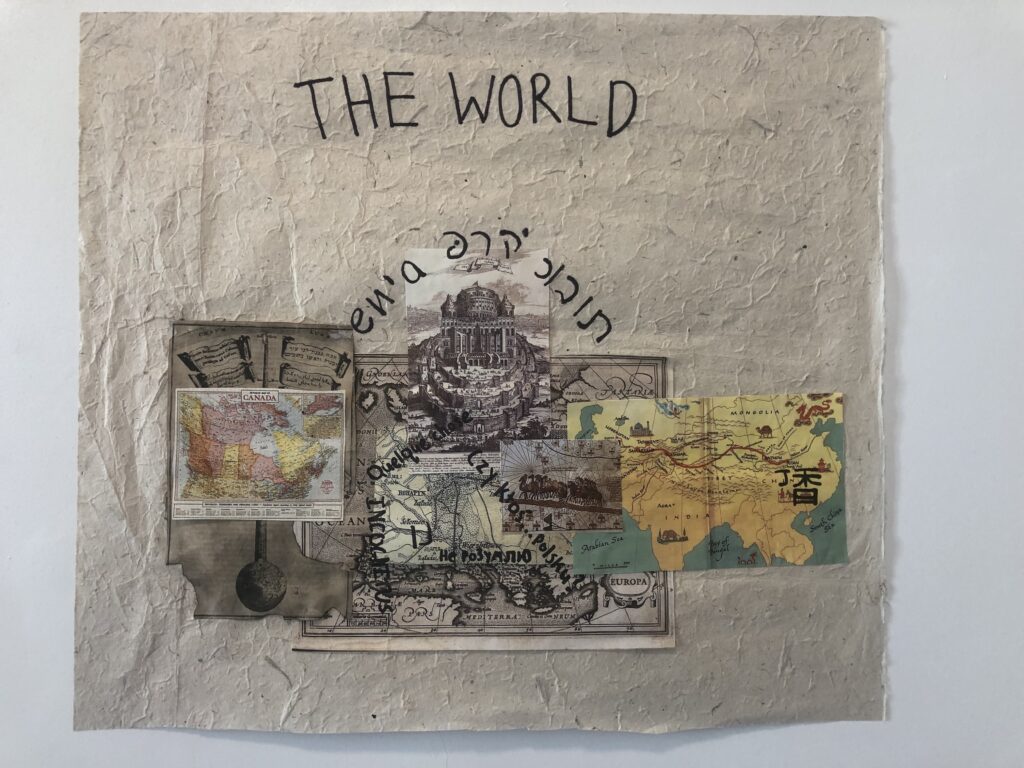
back
The Destruction of Rohatyn: Circulation of Times
This section of our creative cartography also deals with Book Seven. It is inspired by the quote:
In 1774, the library was taken over by the Commission of National Education, and in 1795, after the final partition of Poland, the library was sent in its entirety to Petersburg, by order of Catherine the Great. Having taken several months to make its way, in carts and wagons, it remained there until the First World War. In 1921, the collections were partially returned to Poland, but they burned during the Warsaw Uprising.9
This quote recounts how Chmielowski’s collection, which he discussed in the first Book, eventually got destroyed. We treated this as a metaphor depicting how much of Europe was destroyed during the wars and how different dimensions of time are connected. To make this we burned a page of Chmielowski’s book New Athens (1745-1746), to represent how his book was physically burned but so was the civilization that was displayed throughout the story—a Holocaust, the massive destruction of European Jews by the Nazis, in Hebrew “catastrophe” (השואה, HaShoah) or in Yiddish “disaster” (חורבן,khurbn), whose Greek root “holokauston” (ὁλόκαυστον) literally means “completely burned.” The cave shaped like the Hebrew letter aleph (א) serves as a symbolic vehicle: it is the one, of which Jakub Frank says that Abraham rests there and that it was miraculously transferred from the Land of Israel, and where, according to his words, he was born as the Messiah, served on 12 October 12 1942, five families from Korolówka, Jakub FranK’s birthplace in 1726, to save themselves from the Holocaust. It is the same cave where the body of the all-seeing Yente was laid to rest.
Thus, from right to left, like Hebrew script or life, the thread of time unfolds while its spatial and existential dimensions telescope. Thus, this is on the far left of the map, so it represents the end of the story that we are telling in our cartography. However, on top of this burnt book, we placed a map of Canada to represent how, out of this destruction, a new life emerges. This follows Tokarczuk’s pagination of the book: the end of the book is the first page. In this way, the end is also the beginning.
back
Book II “The Book of Sand”: “You are just at the beginning of the road now”
Esther Kay (Sciences Po Paris/Sorbonne University), and Aurèle Martchouk, (Sciences Po Paris).
For this creative cartography, we worked on the second chapter of the Books of Jakob, entitled “The Book of Sand.” This book opens on the description of a caravan of merchants joined by two Jewish characters, Nahman Samuel Ben Levi and Mordechai (Reb Mordke). We follow their journey starting from the moment they meet, and different adventures, such as a wedding, the discovery of Isohar’s religious school and their acquaintance with Jacob.
The excerpt we chose to work on follows their journey to Smyrna, the city in which they are supposed to pursue their economic activities as well as their religious and philosophical quest for the Messiah:
In Lwów, Grzegorz Nikorowicz, an Armenian, operated a Turkish trade—he mostly imported belts from Turkey, but he also dealt in carpets and rugs, Turkish balsam and weaponry. He had settled in Stamboul, to keep an eye on his business from there, and every so often his caravans with their valuable goods would set out for the north, then head back to the south. Anybody could join in with them, not only Christians—anyone who demonstrated good will and had enough money to chip in to pay the caravan’s leader and the armed guards. You could carry goods from Poland —wax, tallow, honey, sometimes amber, although that did not sell as well as it once did—and you had to have in addition enough to sustain you on the road, and once you got there, to invest in goods to take back with you, in order to earn something off the whole expedition.10
The notion of exchanges is central in this chapter. The caravan symbolizes the circulation of goods, but also of information and ideas in Europe. It represents the unfolding of a journey, a process that is both spatial and intellectual. Indeed, it appears that the characters are physically making their way in eighteenth-century Europe, while at the same time progressing spiritually, learning, and discovering. Therefore, the path followed by the merchants is a transformative journey, shaped by the cultural, religious, political and linguistic peculiarities they encounter. This is encapsulated by the moment when Reb Mordke meets his disciple in Busk and declares: “You are just at the beginning of the road now. If you were to travel further down it, you would see the world around us now is already ending [...]. [...] the Messiah [...] is in Smyrna.”11 Nahman concludes: “Mordechai suggested we go south together, uniting business and our search for the truth.”12 This double aim—trade and spiritual quest—is what we have tried to represent on our map, by superimposing three layers.
back
Goods and Economic Exchanges: “Overlapping panthers, squiggles, tangles, trails”
The first layer is made of goods from the eighteenth century circulating from the Turkish cities of the Ottoman Empire, such as Izmir and Istanbul, to Poland (at the time Polish-Lithuanian commonwealth), territories which shared a long border in the regions of Moldavia and Galicia as suggested in the excerpt already quoted.
We had to go through a long research process for this layer and explored the online collections of museums and antique sellers to find some historically accurate goods traded at the time.
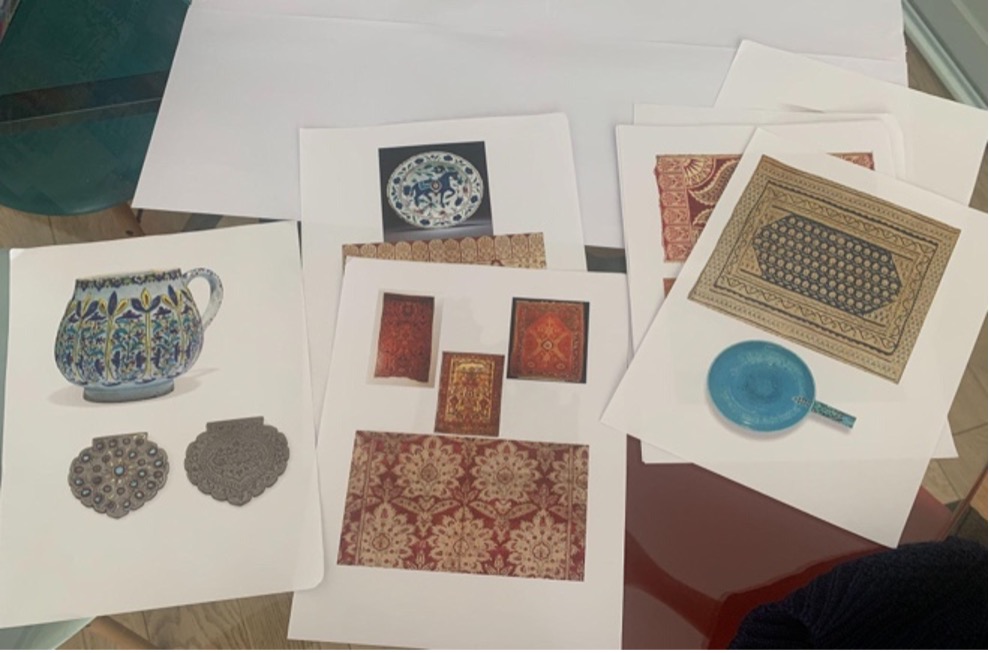
On the one hand, we chose to use orange-colored traded materials to represent the Polish-Lithuanian commonwealth as orange is the color of amber, coming from the Baltic. On the other hand, we chose to use Turkish materials to underline the connection with the Ottoman empire that had reached its greatest extent at the end of the seventeenth century.
Turkish traditional carpets—kilims—, mentioned many times in the book, are the material we used most often. These Turkish carpets represent the development of the characters’ philosophical and religious thought through the journey and more specifically of the concept of tikkun (in Hebrew תיקון עולם, reparation, action and improvement of the world). This use of kilims is inspired by the passage about Nahman’s writing process: “His writing on the lid of the case set up on his lap, in the dust and discomfort of travel, is in essence tikkun, the repair of the world, mending the holes in its fabric so filled with overlapping panthers, squiggles, tangles, trails.”13 Using a collage of kilims as the first layer of our map seemed appropriate as it would visually evoke this restoration process.
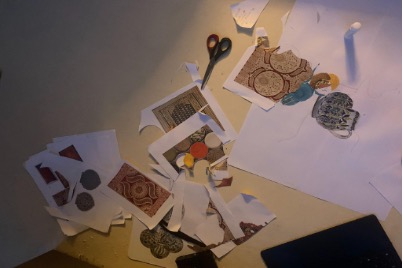
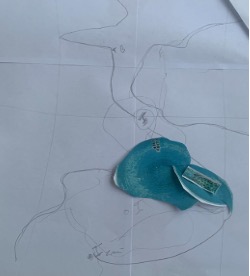
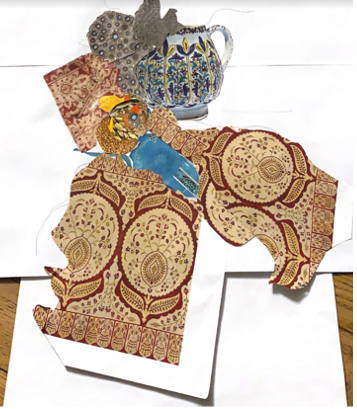
Fig. 3, 4, and 5. Creating the first layer, work in progress.
We then had to define how to cut our paper prints and draw the borders. We chose to start working from a map referenced by the author, Europa Turchesca drawn by renowned Dutch cartographer Isaak Tirion (1740). Though the map is not accurate by today’s standards, it corresponds to the way Europe and Asia were visualized at the time. We transferred the pattern of the eighteenth-century map onto our prints of kilims and other materials and found that their designs surprisingly fitted the lines of Tirian’s map borders rather well. In this way, on our map, one may identify Bulgaria, Moldavia, Macedonia…
Finally, we chose to go further by embracing the characters’ perceptions and knowledge of the places they are traveling through. That is why we distorted the scale to give more prominence to cities such as Istanbul, Izmir or Gdańsk, and make them centers of attraction in the map as they were for travelers and traders at the time.
back
Religious and Political Journey: “Being a great sinner”
The second layer represents how the trip to Smyrna leads to numerous discussions and introspections by our characters on religious, philosophical, and political matters. The first debate between Reb Mordke and Nahman happens near Craiova about the Messiah’s role in the human world. Reb Mordke argues that Besht, the founder of Chasidism, and Nahman’s former teacher “has understood nothing”: “the Messiah must come from the lowest spheres, that he must be sinful sinner and mortal.”14 Reb Mordke relies on the book of Isaiah, written in Hebrew, and that’s why we printed the sentence in this language “יש למצוא את המשיח בין […] החוטא.”
Reading the old thinkers and transmitting the previous master’s heritage is an important part of our characters’ intellectual journey. In the same abstract, Reb Mordke gives Nahmman a treatise, Va-Avo-hayom el Ayi’yin (And I Came this Day unto the Foutain) written by Jonathan Eybeschutz, his former professor. From this point, Nahman feels grateful and included in a broad lineage of intellectuals: “I felt then that I had become the next link in a long chain of initiates that extends across the generations, that begins further back even than Sabbatai, than Abulafia, before Simon bar Yochai, than, than…and on, all the way to the dawn of time […].”15
To illustrate this sense of intellectual lineage, we experimented with the use of AI (chat GPT4). Many content creators, even in the historical and literary field, have been using AI in order to fill up the blank of undocumented history. In our case, using AI was a tentative effort to represent characters such as Reb Mordke of whom no representation is available, to our knowledge. However, the outcome seems underwhelming as the images produced by AI draw on the stereotypes of the global memory of Jewish culture and fail to rely on historically accurate data. Still, it provides an illustration of the notion of intellectual genealogy and perhaps reflects the way readers construct mental images based on cultural, historical and literary collective memory as they process literary texts. It would take more research to feed the AI tool with more specific material to obtain satisfactory results.
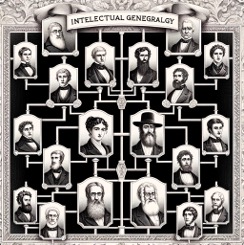
The journey of our characters is also a source of political awakening, especially on the situation of Jews in the region. We tried to represent this through an episode of The Book of Sand, when Jakob is applauded for his courage because, at the age of fifteen, he stole the money collected from taxes imposed on Jews. On this occasion, Reb says “You pay because you’re Jewish” (in Yiddish: איר באצאלט װײל דו ביסט א ײד). The quotation epitomizes the questioning of the position of Jews in the social sphere as Nahman and others discuss politics and social inequalities. We copied this short quotation on the map, along with an engraving of Jakob found in an 1895 Polish book by Aleksander Kraushar entitled Frank and Polish Frankists, 1726-1816: historical monograph (Frank i frankiści polscy 1726-1816. Monografia historyczna).
back
The Path of Languages: “You are just at the beginning of the road now”
One first challenge in the making of the third layer of our map was to accurately represent the route followed by the merchants from Poland to the Turkish Empire. We had to reconstruct their itinerary by looking for all the locations mentioned in the chapter. The main quote we used is the following:
This is a caravan that set out a few days ago from Smyrna, heading north through Constantinople, and then through Bucharest. Along the way, it will splinter, and others will join in. Some of the merchants will break off for in just a few days, in Stamboul; they will be travelling through Salonika and Sofia to Greece and Macedonia, while others will continue all the way to Bucharest, some even to the very end, along the Prut to the Polish border, which they’ll cross, besting the shallow Dniester.16
Those indications were sometimes vague, which is why we had to deduce some steps of the route. Google maps was of valuable help in this process.
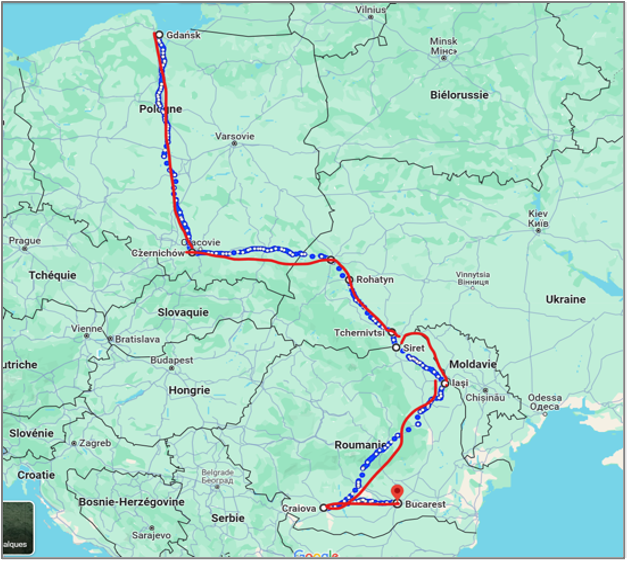
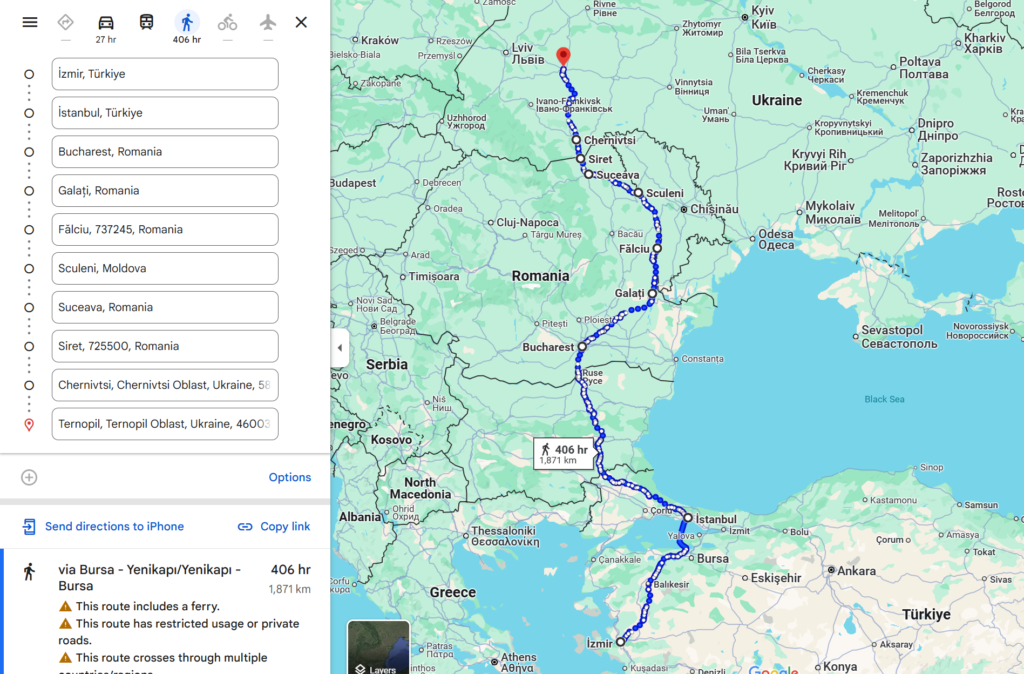
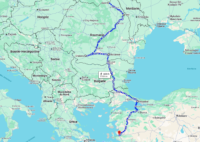
Fig. 7, 8, and 9. Itineraries created on Google Maps.
We decided to materialize the route as a long sentence sinuating on the map, a quote that would embody this idea of a spatial and intellectual journey the characters have been following. The quote previously mentioned17 seemed to perfectly fit this idea. It became the path followed by our heroes, like a mantra repeated in their quest for the Messiah.
Besides, we divided this quote into six parts and translated each one into one of the languages found in the book. Then, we hand-copied the six-fold sentence on layer three, making it start and end in Yiddish, to represent the idea of a circulation of knowledge through Jewish communities:
“You are just at the beginning of the road now” (in Yiddish: איר זענט פּונקט אין די אָנהייב פון די וועג איצט);
“If you were to travel farther down it, you would see the world around us now is already ending” (in Polish: Gdybyś poszedł nią dalej, wiedziałbyś, że ten świat wokół już się kończy);
“and that is why you see it as if it were untrue” (Români: și de aceea o vezi de parcă ar fi neadevărată);
“and you detect not the light from the outside which is false and illusory” (in Bulgarian: и не откриваш светлината отвън, която е фалшива и илюзорна);
“but rather the light that is internal, that comes from God’s own scattered sparks, which the Messiah is to regather” (in Turkish: daha ziyade, mesih'in yeniden toplayacağı, Tanrı'nın kendi dağınık kıvılcımlarından gelen gerçek ışıktır);
The messiah is coming now, he is in Smyra” (in Yiddish: דער משיח קומט וויסן, ער איז אין סמירנאַ).
Handwriting this long, multilingual sentence was an interesting experience, which put us in the shoes of medieval copyists confronted with diverse alphabets and languages. As found in the description of the city of Rohatyn: “Say one word in a room in Rohatyn and soon it will be carried all around the world, on the paths and roads taken by commercial expeditions, with the help of the messengers who roam the earth incessantly, bearing letters and repeating gossip. Like Nahman Ben Levi of Busk.”18
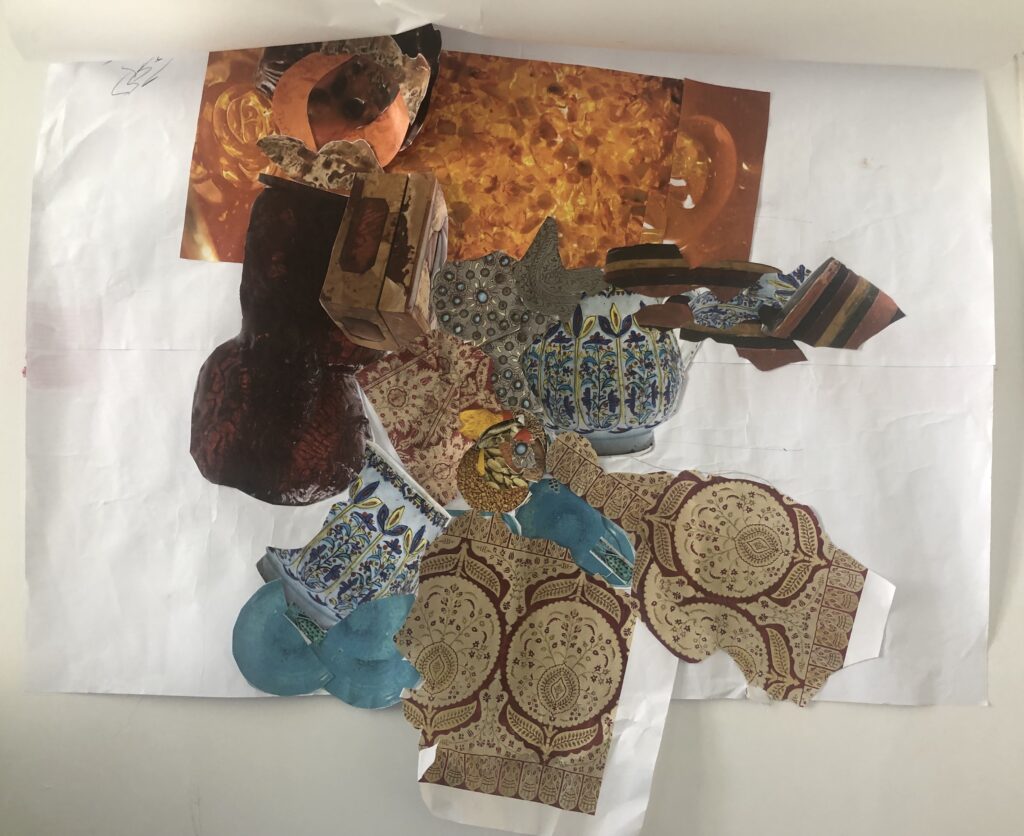
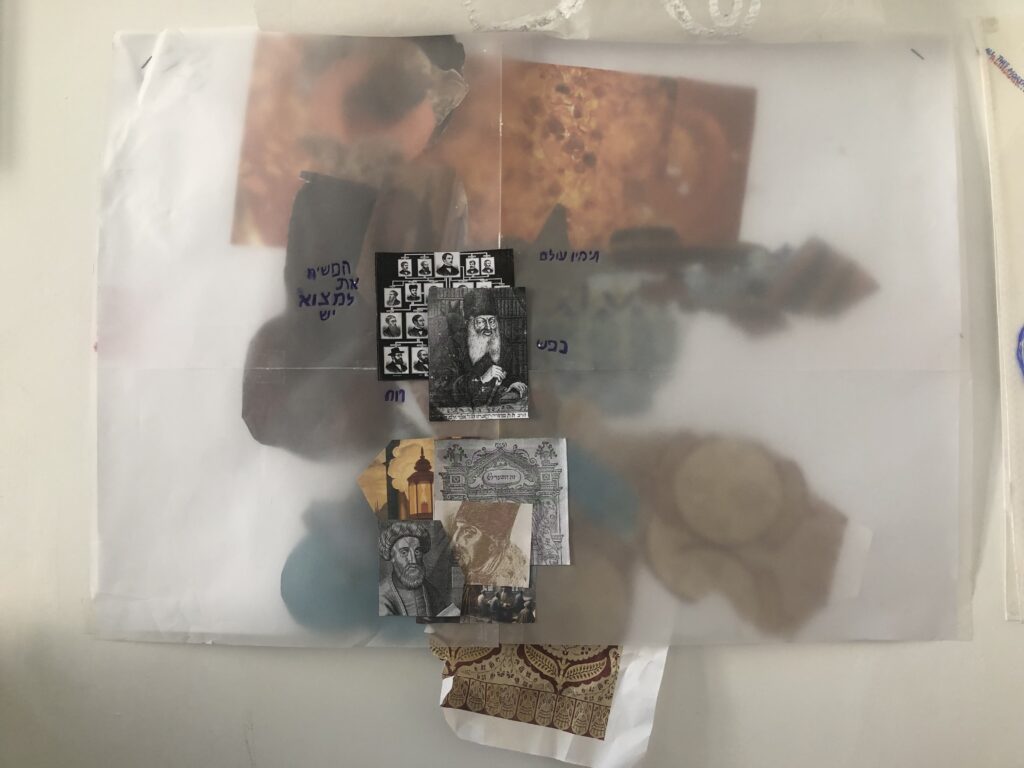
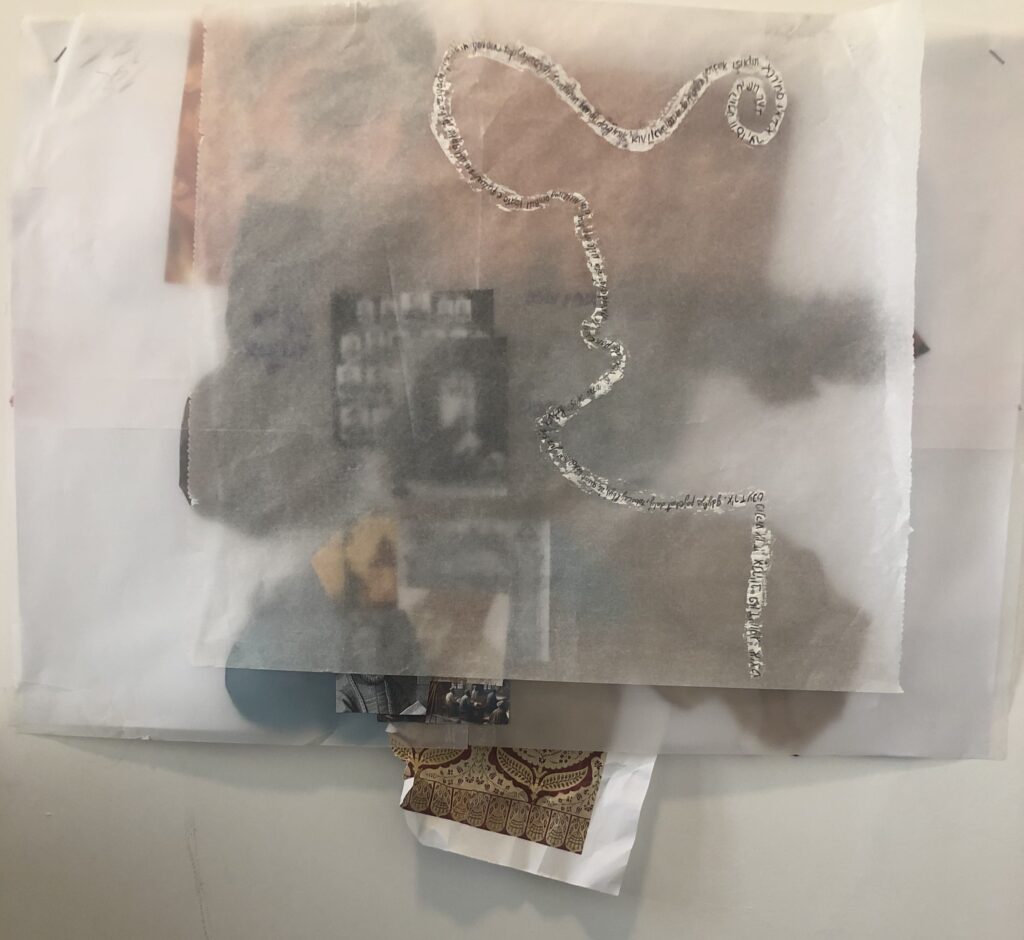
Fig. 10, 11, and 12. Final layers of the cartography.
It was the first time we worked with creative cartography. This project made us read The Books of Jakob in a different way, as it made us more attentive to the duality and interference between geographical space and spiritual thinking depicted in the book. We became aware of some subtleties in the heroes’ journey as we had to produce a visual representation of it. A religious or intellectual system is shown to be constantly changing, shaped by debates, discoveries and linguistic or material exchanges. Producing a real paper map provided us with the physical experience of cutting, assembling, layering, overlapping and patching. Those gestures resonated with the intellectual experience of elaborating new ways of thinking, including its tentative aspects, experiments and winding paths.
back
Book III “The Book of the Road”: Challenging Women Empowerment
Luke Jacobson (University of Michigan/Sciences Po Paris), Nekane Martin Vallejo (University of Salamanca/Sciences Po Paris), and Ielyzaveta Pliatsuk (Central European University Vienna/ Sciences Po Paris).
Our cartography explores the relationship between men and women throughout the third book of Olga Tokarczuk’s The Books of Jacob. This book centers on Jacob Frank, a Polish Jewish man who claimed to be the Messiah and founded a religious movement called Frankism in eighteenth-century Poland. Specifically, this analysis focuses on the third book in the series, titled The Book of the Road. Jacob’s perception of norms and morals deviates significantly from the conventional ways of living of his time. Through his Messianic mission, he introduces the reader to his version of “normal,” creating an upside-down reality for men, and especially for women.
We wanted to explore how women are treated and what their role is within the story, particularly as they relate to Jacob Frank and his untraditional philosophy. Jacob is far from an ordinary figure within the book, and this might be especially true when looking at his relationship with women. For instance, the views of women at the time were molded by values that preceded what most people call “first-wave” feminism. In today’s terms, they would be considered conservative and traditional, where women had less autonomy, and were primarily considered to be caregivers and housewives. Yet Jacob Frank takes a somewhat more liberal view of women, marriage, and sexuality, in certain regards, and this is played out within his religion as well as his general actions. By liberal, we mean untraditional as well as somewhat modern for their time. It’s not just Frank, though, who has these views; because he is the leader of a group of people who follow him as the Messiah, there are other people who begin to enact these somewhat liberal positions as well.
This is precisely what we wanted to explore in our cartography. We chose to approach this by taking certain quotes from the book that highlighted or gave insight into the way women were treated or viewed within the small “tribe” of Frankist followers. For instance, we have quotes that highlight the sexual tendencies within the Frankist tribe. In particular, the act of polygamy on the part of Jacob. We show how he chose to have sex with several of the women who were married to other men, thus shedding light on a very untraditional practice. We chose to use the quotes to trace the physical path that Jacob and his followers took, thus highlighting the importance of geography within the story.
We also decided to separate our exploration of women’s and men’s views on women, respectively. We also decided to split our cartography into two pages of quotes attached to our map, where we explored men’s views on the right, and women’s views on the left. We felt the difference in views was extremely stark, and thus merited an in-depth exploration. In this regard, the viewer can turn a page and explore how women viewed women, or how men viewed women. Or, they can flip both pages and explore them in tandem.
back
Female Empowerment and Disempowerment
Out of the more than fifteen quotes we initially considered for our cartography on the role of women in Jacob’s society, we narrowed it down to ten that were particularly significant. As we worked on our final project, space constraints led us to include only eight of these quotes. We categorized these quotes into two groups: those that we thought empowered women, and those that we thought oppressed them.
The first group concerns the disempowering quotes—those undermining, belittling or limiting the role, value and potential of women, and reinforcing stereotypes that contribute to the subordination of women in society:
1. “Although Jacob gives up the light-haired girl in Lwów, Gitla he keeps. In any case, the light-haired one is soon replaced”19—The quote suggests that women are interchangeable and disposable, reducing women to objects that can be easily replaced and emphasizing their perceived lack of individuality and value.
2. “An educated woman is the cause of many misfortunes”20—This quote states that women’s education and intelligence can lead to negative outcomes, which is a demeaning and limiting view of women’s capabilities and potential.
3. “How did it come about that Hayah [a woman] was granted so much license?”21—This quote reflects a patriarchal mindset by asking why a woman, Hayah, has been given freedom or authority, suggesting that women should not have such liberties. It views women as subordinate and questions their right to autonomy and independence.
4. “[…] religious scholars keep their distance from them, for women’s inherent connection with the lowest world of matter introduces chaos into the world of the spirit”22—In this quote women are portrayed as sources of chaos and impurity in the religious context. It implies a belief in women’s inferiority or uncleanliness based on gender stereotypes.
The second group concerns the empowering quotes—that uplift, validate or promote the capabilities, rights and roles of women—sometimes challenge traditional gender norms.
1. “All this mortal Loving is valued too highly […]. Perhaps only Women have access to it”23—This quote empowers women by suggesting that they may have a unique or special connection to mortal love, implying a deeper emotional understanding or experience.
2. “She [Shekhinah] will guide them to the bishop’s residence like a mother, like a sister, like the most tender lover who would give up everything just to gaze upon her beloved [one]”24—Shekinah is depicted as a nurturing figure, embodying roles of motherhood, sisterhood, and romantic love, empowering women through their caring nature and ability to form deep emotional bonds.
3. “She [Hayah] can be overbearing. […] Everyone, even her father, fears her quick steps, her shouting when she disciplines the children, when she fights with the man”25—The quote portrays Hayah as an assertive and strong woman. While her assertiveness may be intimidating, it reflects her confidence and independence, challenging traditional expectations for women to be passive and submissive.
4. “The women of the true faith are confident and gregarious. They like to flirt, and what Jacob teaches them: that they can forget the Turkish customs dictating that they should be shut up inside their homes”26—The quote highlights the confidence, sociability, and flirtatiousness of women in the “true faith,” empowering them by defying cultural norms that limit them to domestic roles.
Despite several instances of empowerment, the quotes that subjugated or disempowered women were far more numerous. Moreover, some of the quotes that seem to empower women are nevertheless rooted in a stereotyped view of women. For example, there is a common trope within the quotes that women are to be associated with emotionality. This observation underscores the prevalence of attitudes and beliefs that may diminish the role and value of women within Jacob’s society.
back
Rethinking Color Stereotypes
Another component was the choice of colors within the cartography. In many Western societies, blue is stereotypically associated with boys, while pink is associated with girls (for our cartography we used red instead of pink since it is a completely contrary, primary and independent color). In the context of the story in The Books of Jacob, women are associated with the color red in the first Book which was derived from the color of their period blood.
Our group deliberately challenged traditional gender stereotypes and associations by representing women with blue and men with red. Thus, we aimed to encourage viewers to rethink and question prevailing societal norms.
back
Tracing Jacob’s Journey
Since the project was called “cartography,” we realized that our previous ideas addressed spatial dimensions, but not geographic. Therefore, we decided to include a realistic map as one of the layers for the final draft. Originally, the trace of Jacob’s movement throughout the chapters looked like the image on the left. However, this trace did not work with our central character imagery in the middle —it would distract the audience and not work graphically with our concept. It became evident that it needed to be flipped to either side. Eventually we came up with an idea of flipping it to the left. This is because if one would imagine himself to be Jacob in the starting of his journey (facing North to South)—what we call today Israel would be on the left (if you flip the world map upside down, Israel would be located more left than Eastern Europe).
Upon executing the drawing, we found that a dotted format was the most effective. When two plastic layers are placed one on top of the other, the view can be imperfect, with red sometimes covering blue and vice versa. To avoid adding another layer of abstraction for the viewer, we chose to use dotted lines. Additionally, after careful consideration, we decided not to include the cities in the final map, as they did not significantly align with our concept.
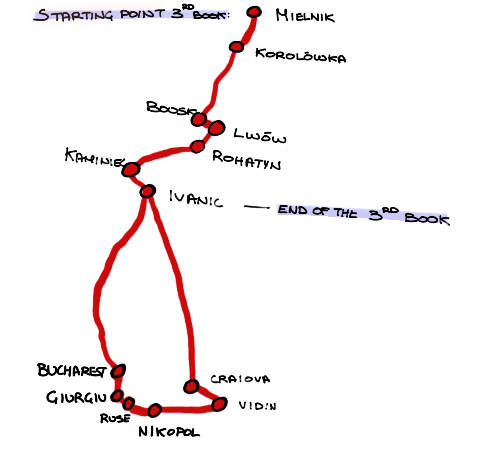
back
Imagining Otherness
Another issue concerned how to represent characters and especially Jacob. We decided to depict him as an alien in the final cartography. That symbolic depiction represents his being withdrawn from the “normal” perception of the way of life which is accepted by surrounding society. His pose as well as the layout of the rest of the male characters is intentionally reminiscent of the one of Jesus in Leonardo da Vinci’s The Last Supper. We decided that the comparison between Christianity and Jesus to Judaism and Messiah is a relevant juxtaposition. The way we could express it is to unite elements that are inherent to Jacob himself and Christianity, especially that he converted to Catholicism.
Furthermore, Jacob is dressed similarly with a cloth stemming from the left shoulder which strengthens the symbolic depiction. The hat on Jacob’s head is a form of traditional Turkish headwear: a fez. The beginning of the third book starts with him and others crossing the border from Turkey to Poland. Furthermore, a lithography was later published of him portraying him in a fez. Thus, the decision was made that the fez would strengthen the audience’s understanding that the alien is Jacob.
The rest of the men surrounding Jacob look like they are from the eighteenth century—which was a product of our group debate. It was decided to make the men look as if they do come from the timeframe when the book is unraveling. Moreover, they are wearing clothes that we thought would look like ones of merchant-travelers of the 1750s. Surrounding them are objects like a globe and a compass to further show that the group is relatively open minded for their time. In our view, open minded could correspond to geographical open-mindedness, like a globalized outlook on the world which was revolutionary for their time. With the use of different headwear, we tried not to represent a certain nationality, but instead made it more discrete in where the men came from. Indeed, the followers of Jacob in the story aren’t all belonging to a single ethnic/language group. Therefore, thanks to their antennas, they are connected to Jacob.
The women are standing on the sides of the image, keeping distance and not touching the men—just as it seems to be described in the chapters. Even though women had an abundance of physical intimacy with Jacob and their non-husbands, their life seemed to be separated and disconnected from those of the men. The two characters we picked were Hayah (left) and Gitla (right). These two characters worked the strongest with our aspirations to show how women were treated as sexual objects in the third book. We also included quotes that showed how education for women was largely disapproved of, and how they were seen nearly as servants who served men by doing household chores and fulfilling their sexual desires. Their choice of clothing attempted to make it look as if they were wearing clothes that would be worn in Eastern Europe. The clothing they wore was based upon the descriptions of Gitla and Hayah within the book.
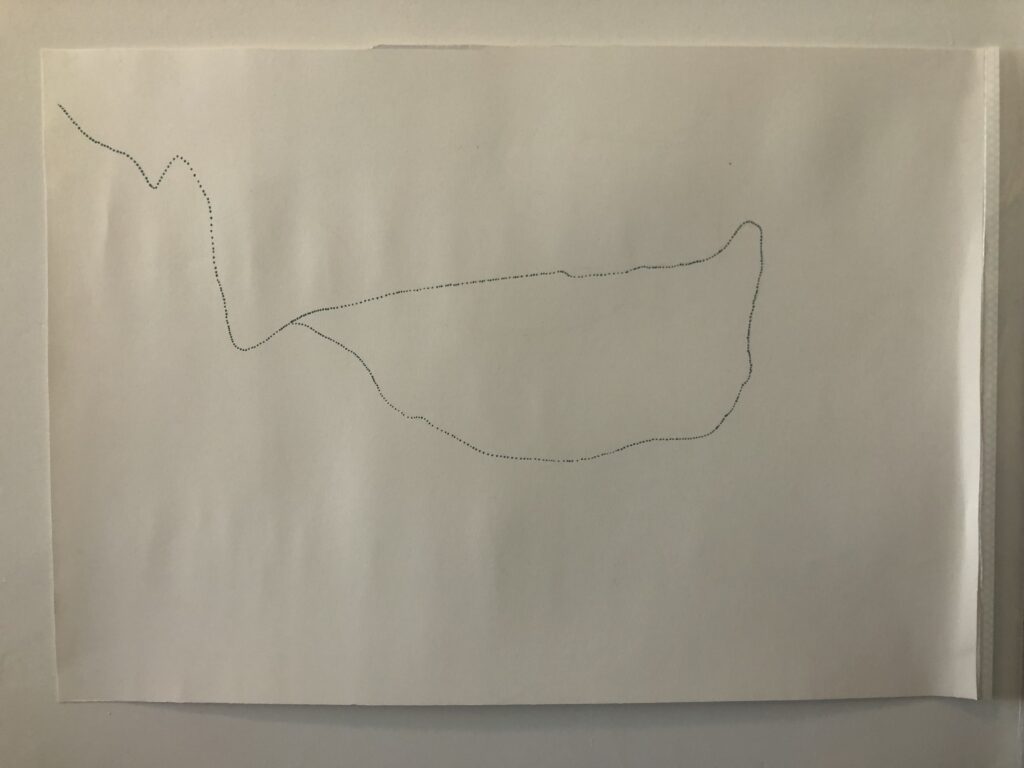
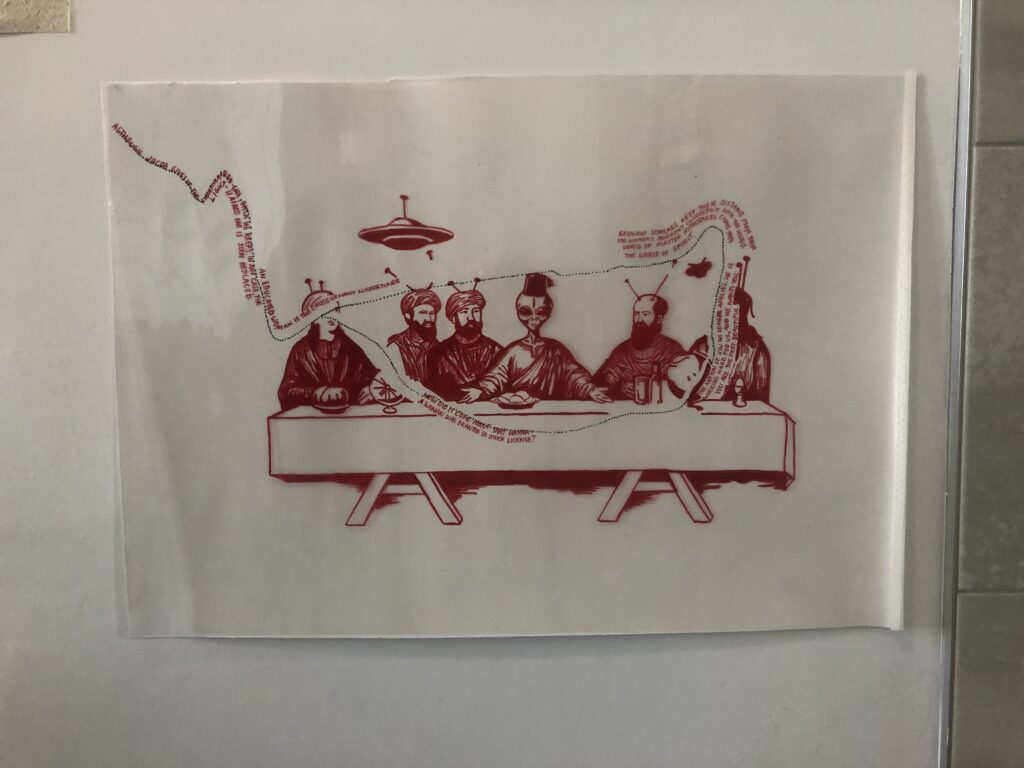
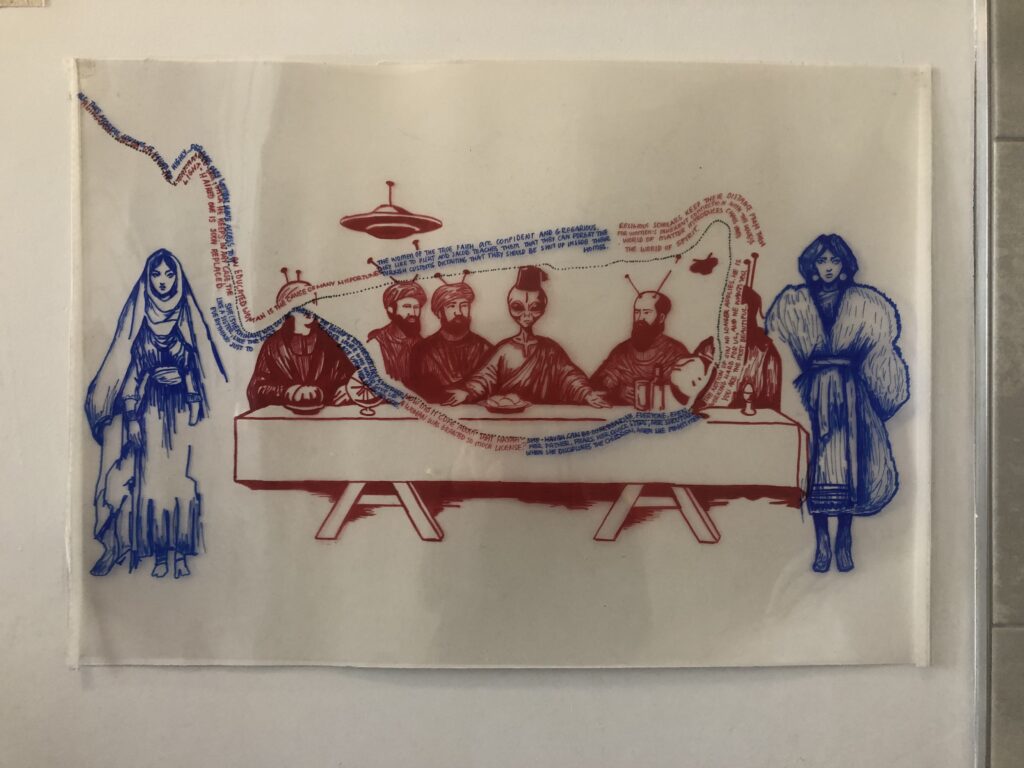
Fig. 14, 15 and 16. Final layers of the cartography.
Our creative cartography explores the nuanced perception of women in Olga Tokarczuk’s The Books of Jacob. We found that the rhetoric within the unconventional religious movement started by Jacob Frank empowered women in certain ways. Despite this, most of the empowering quotes were in relation to the emotions and affects of the women in the story. Because of this, we felt that they preserve and sustain gender stereotypes. Our use of colors and symbols were most vital in conveying the meanings implied in our work, and the geographical traces of Jacob’s movement as well as the portraits of certain characters highlights the intersection between physical movement and ideological shifts. This project not only sheds light on the historical and cultural realities of the eighteenth century, but also allows the reader to critically reflect on contemporary gender stereotypes and societal norms.
back
Book IV “The Book of the Comet”: Under Jacob’s Watchful Eye
Lucas King (King’s College London/Sciences Po Paris), and Kio Katayama (Hitotsubashi University/Sciences Po Paris).
The cartography is based on the part fourth “the Book of the Comet,” which follows the transformation of Jacob Frank, a formerly orthodox mystic and now heretical Jew, into a Polish Christian. The story begins when a comet appears in the sky, visible in a wide range of areas from Europe to China, in 1759. The event is interpreted by Frank and his followers as a sign of the Shekinah descending on Ukraine. The Shekinah is a divine presence, considered to be its feminine aspect. It serves as the motivation for much of the development of Frank’s theology going forward, driving his claims to be the reincarnate messiah, and with them his rejection of Judaism.
back
Comet’s Divine Meaning
The project is especially associated with the context summarized by the quotation: “The sages say that the Shekhinah will pass through this hole”27 As the narration states that “the divine light may pass in order to reach [the world]” through “[the] hole drilled into the heavenly firmament,”28 the comet holds significance in religious understanding. In fact, the approach of Shekinah reinforces Frank’s growing importance and distance from Jewish orthodoxy through his claims to messianic status. With the advancement towards Lwów, Franks’ spirituality becomes less obfuscated and, in a sense, less Jewish. His position at the height of creation gradually draws him closer to the ordered, regimented world of catholic Christianity. It should also be noted that Frank, who never reads most of the New Testament, seems to become Catholic for anti-Jewish, rather than pro-Christian reasons—his resentment at rabbinic Talmudic Orthodoxy is seen. His gradual casting off of those traditions is reflected by the increasingly concrete and visual way his faith is portrayed, as the comet, and with it the presence of God and his own elevation, approaches.
back
Conceptualizing Frank’s Perspective
The cartography project is conceptualized from Frank’s perspective, since his ambivalent moral conditions make it difficult to objectively analyze the other characters’ status. Frank is such a controversial, challenging, and complicated figure that it should be most informative to make a map based on a reflection of his own relationship to his spirituality. It signifies that the work reflects not only the transformation in Frank’s worldview from the ephemerality of mystic rabbinic Judaism to the ordered structures of Catholicism, but also the magnitude of the claims he makes about his own position.
The aim is therefore to portray Franks’ own spirituality through the increasingly visual means by which its’ portrayed as the eye of the viewer approaches the critical juncture at Lwów, with the maps’ other features informed by Frank’s own perspective on his spiritual role.
The map is centered in Ukraine and Poland as the areas seem to be where Frank is at the time the comet is observed. The claims which Frank makes about his own place in the order of the cosmos are so consequential that they serve to make the space which he moves through the spiritual center of the world. The map is therefore warped around Lwów, the area in which his status reaches its’ apogee, and rather like a heavy object bending spacetime in general relativity, the magnitude of Franks’ claims to reflect the effect Frank sees himself as having on the world. It also includes Constantinople as it was the home of Greek orthodoxy and the origin of the Sabbatean tradition Frank was heir to, however the city is squashed against the bottom of the frame by the warping of the map, reflecting the way Frank’ emancipated himself from that tradition. The only other place represented on the map is Częstochowa, where Frank was imprisoned, and which served as the spiritual heart of Polish Catholicism.
The comet is placed on the map, a white streak against the maps’ black background to place stronger emphasis on the divine influence and illumination. The object makes one remember Franks’ initial adherence to and membership in the traditions of Ashkenazi Jewish mysticism by evoking the focus of those traditions on the ephemerality, impersonality, and transcendence of religious experiences. It also consists of Hebrew characters forming the words, in “The sages say that the Shekinah will pass through this hole.”29 The quotation is in Jewish calligraphy. Its abstract esotericism of the artistic form is slightly in conflict with the messianic message contained in the comet’s shape. Furthermore, the comet surrounds a hamsa-hand, the symbol common in Misrahi Judaism. The hand expresses the impact of Sabbatai Zevi on Frankism and Franks’ own relationship with God. The hand itself is in the style of the drawings which adorn the inside of Eastern European Synagogues to contrast this Sabbatean influence with Franks’ own Ashkenazi roots. Since the hamsa is an artistic form rather than a distinct symbol, it is filled with two candles, symbolizing Shabbat, the bride of Shabbat and the covenant between God and his people. As the reincarnation of the Messiah, Frank sees himself as the fulfilment of this bond between God and man, and the hamsa therefore serves to represent the coming of the Shekinah and with it his elevation.
The eventual fulfilment of this promise through Franks’ own conversion to Catholicism, or rather his rejection of Judaism, is represented by a version of the Black Madonna of Częstochowa with a drawing of Frank himself in place of the Christ Child. The Shekinah, as already mentioned is often characterized as female, as is the bride of Shabbat, and Frank therefore becomes the product of this feminine divinity in place of Jesus. His replacement of Jesus here also serves to further underline the extent to which his conversion was due to a rejection of the Talmud, rather than his embracing of the Bible.
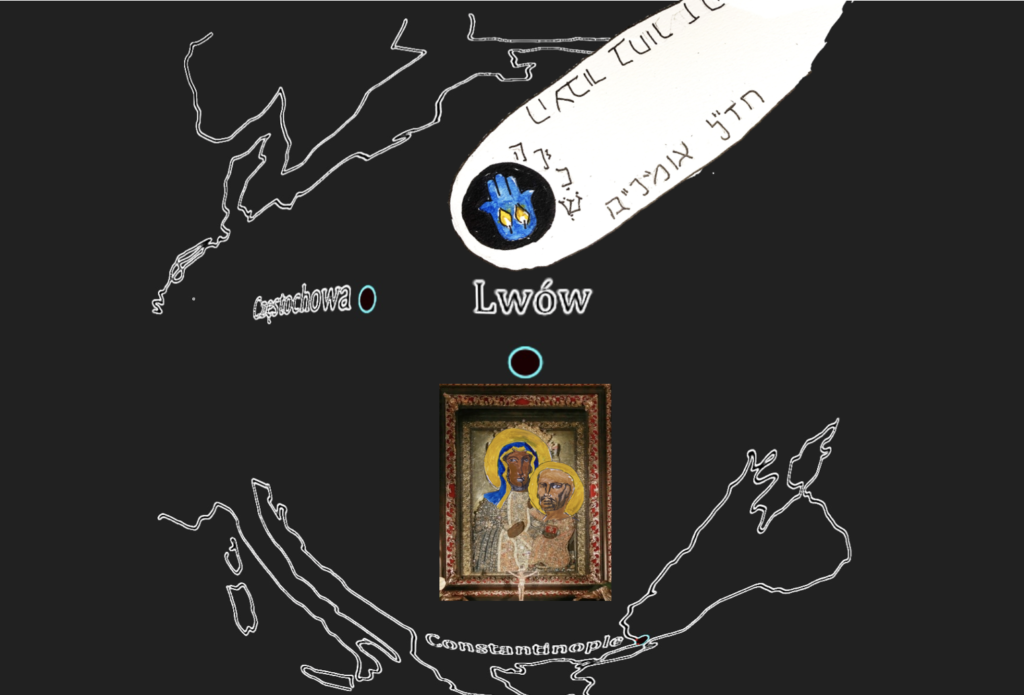
The project began to create a cartography map based on the symbolic event of the comet. The work intricately maps Jacob Frank’s spiritual journey from Orthodox Judaism to a Christian identity, guided by his interpretation of a comet as divine. The map illustrates Frank’s transformation, culminating in his symbolic adoption of Catholicism. The creative idea stresses the inclusion of Jacob’s own views into the visual elements; the entire structure is distorted to express his spiritual centre of Lwów. This narrative is successful encapsulating Frank’s complex theological evolution amidst broader religious and cultural landscapes.
back
Book V “The Book of Metal and Sulphur”: Bathed in Light
Camylla Wiser (McGill University/Sciences Po Paris), and Ulfah Irdina Binte Affandi (National University of Singapore/Sciences Po Paris).
In this book, Olga Tokarczuk portrays the endearing spirit of Jews during the Frankist messianic movement. She aptly contextualizes the Jewish messianic milieu, characterized by mass movements and changes in not only religious terms but also the social and emotional. In chapter fifth, Tokarczuk traces the diasporic lives of Jacob Frank’s disciples as Jacob becomes imprisoned. Through her decadent descriptions steeped in religious and spiritual imagery, Tokarczuk was able to capture the monumental feelings of uncertainty, movement of people and their spirit of adaptation in the face of change and negative discrimination by society in a way that frames the narrative as a grand and magical adventure.
The children-like light lamp we designed as a creative 3-dimensional cartography seems to fit perfectly with this theme of dream-like images and feelings of adventure as established by Tokarczuk.
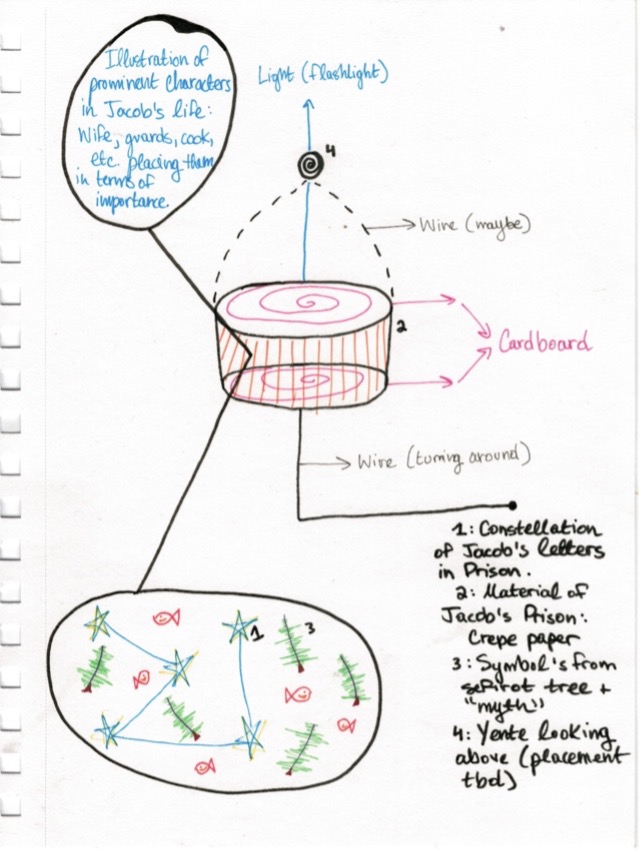
back
Representing Jacob’s Enclosure
As Jacob in prison represents an important part of the book, portraying him in these conditions was central for our cartography. We wanted to show how the world around him is changing while he, the most important person in this messianic movement, is immobilized. It is important that this cartography explores how people during this messianic movement negotiate their sociological selves in diaspora, moving to Warsaw, adopting new names and negotiating a new religion and adapting into new lives.
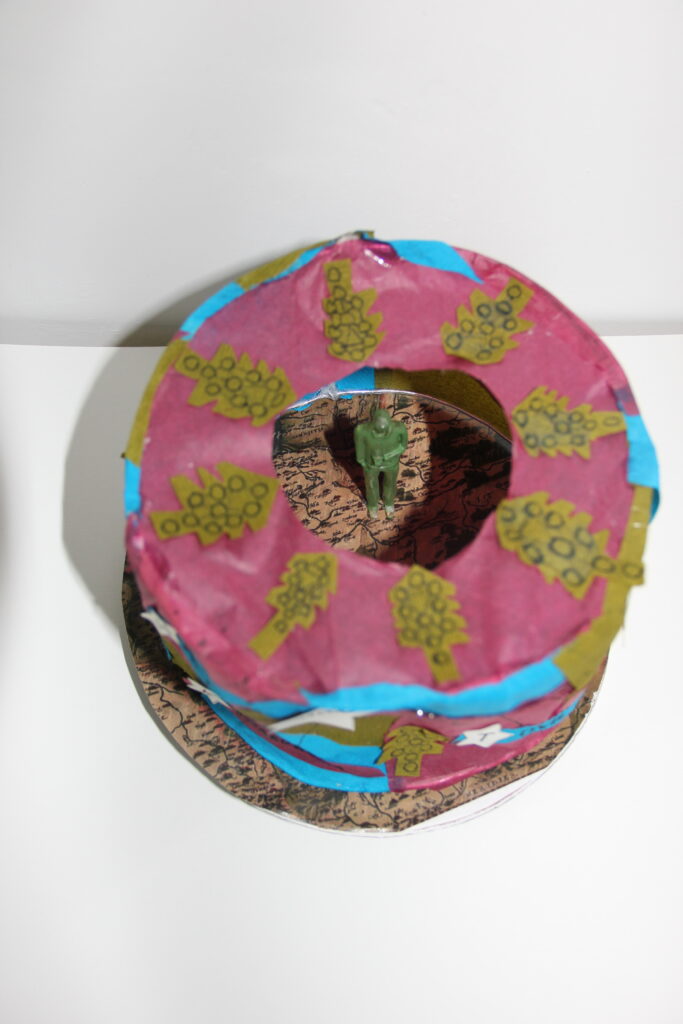
The crepe paper symbolizes the prison walls. The 3D aspect of this cartography and the physicality of the crepe paper physically manifests the physical barrier, enclosure and claustrophobia that Jacob feels from the outside while he was imprisoned. But at the same time, the prison walls were also decorated with landscape and greenery because it is supposed to symbolize the world outside of Jacob that is spinning and changing without him.
This cartography forces us to be wholly involved in the experience. By holding the light and spinning the prison walls, one is enraptured into the story, physically involved in the narrative of the book, forced to have a lived experience.
Another important aspect that we highlighted was the idea of Jacob being seen as the green light as when Nahman says to his wife Sofia Jakubowska while comforting as their babies had not survived:
Don’t be afraid. […] Can’t you see that we are all bathed in light, don’t you see how all our faces have changed, how we’ve grown more beautiful? And that light over Jacob? Can’t you see it? A green glow. We are all chosen ones now. God is in us, and when God is in person, he is no longer bound by any ordinary rules.30
Jacob painted in green creates a “glowing Jacob” effect in our cartography which symbolizes Jacob as a beacon of light that followers of Jacob associate as being a spiritual invigorator and guide. In Nahman’s “scraps,” we get a privileged insight into Nahman’s personal psyche. It is through this, we see Jacob truly in the eyes of his followers. How Jacob is enchanting and appealing to his followers and is seen as someone who brings warmth and light into the dullness of people’s hearts. Therefore, it is important to highlight the follower’s perspective of Jacob to show how important he is in acting as a spiritual invigorator and guide to all the followers.
To localize Jacob and his disciples in their diaspora, the map of Poland forms the base of this 3-dimensional cartography, Jacob stands in the center of the map, representing him as the fountainhead of this movement.
back
Using Color, Illustrating Emotions
Our mosaic pattern encompasses Jacob’s cell to demonstrate how the emotions of hope, anguish, spirituality, betrayal, and anger surround him through his time in the monastery. They also embody how the letters that are both sent to him, and are received to him carry these emotions to Jacob and his followers. They turn around Jacob always, along with the letters, and his physical and mental state are impacted by these emotions in his cell.
When the light shines through these colors, they morphed into brighter versions of themselves. The colors sometimes blend together, and new colors shine through. This shows how both the happiness Jacob brings to his followers through his letters give them hope, and how these emotions sometimes blend in a mixture of anger and faith. Within their movement, Jacob’s followers go through scrutiny and hatefulness by the people around them in Warsaw. However, their emotions blend together when confronting this attitude, and also receiving guidance and instruction from Jacob. This cartography makes audiences understand that emotions that were felt were not linear and clear cut but most of the time complex and mixed. Their lives are turned upside down: however, their faith makes them believe that this must happen for the utopian society to be achieved.
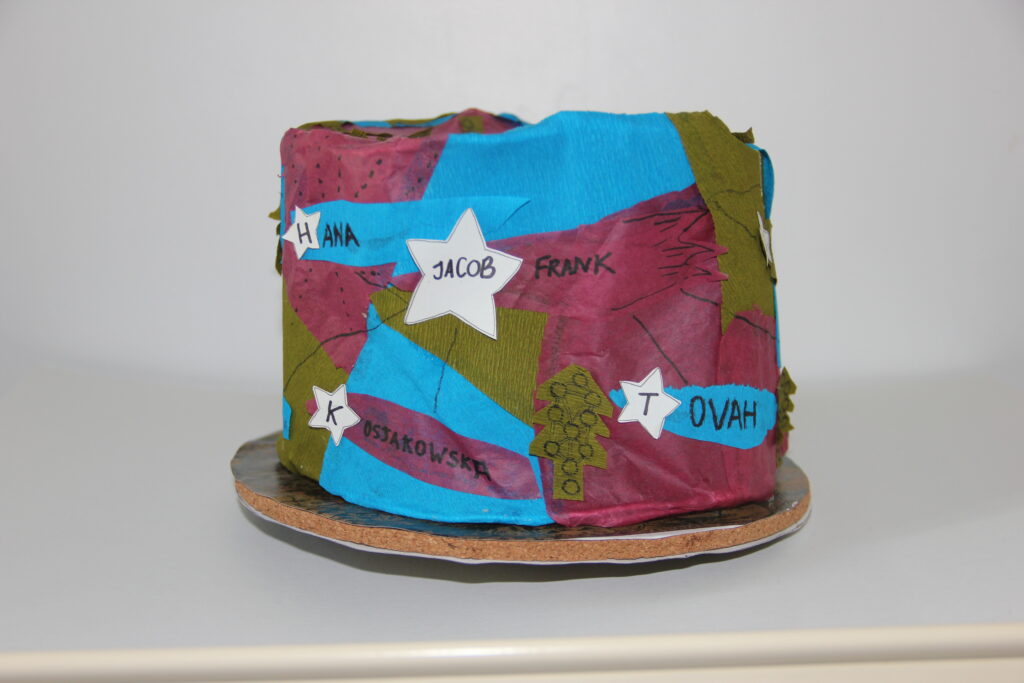
We opted for the color red to convey Jacob’s tumultuous emotions of betrayal and anger, which we deemed pertinent to address at that juncture. Red, with its rich symbolism, evokes notions of blood, sin, vitality, and sacrifice. Blood is an important theme that appears frequently in Tokarczuk’s writing:
[…] a woman dressed as a Jew […] goes to a local priest and introduces herself as the wife of Wojsławice rabbi. She doesn’t say much, only that she overheard that her husband and some others killed a child for Christian blood, as […] they need blood for their holiday matzah.31
Here, blood carries significant cultural weight, particularly for Jews of that era, marked by instances of persecution and false accusations of killing Christian children for their blood. Thus, the symbolism of blood not only underscores the vulnerability of the Jewish community but also serves as a poignant reminder of historical injustices and the Jewish lives that were sacrificed during that time. In Jacob's narrative, it serves as a powerful metaphor for the turmoil he experiences, where bloodshed becomes intertwined with feelings of betrayal and the imperative to take action. Yet, amidst its associations with violence and suffering, blood also embodies vitality and life, like in this quote: “If Nahman were here, Jacob would hit him in the face and watch the bloodstream from his nose.”32 Blood shed is seen as a sign of action being done and executed out of the will of emotions: “They freeze, and now you can hear their uncertain, shallow breaths, the roar of the blood in their veins, the beating of their hearts.”33 Therefore, Tokarczuk highlights the function of blood as the medium of life and the vessel that brings vitality and action, deftly infusing the narrative with a sense of resilience and endurance.
We opted for the color green to represent Jacob’s green light (as Nahman describes), as well as the feelings of hope and prosperity that Jacob’s followers feel when receiving his letters from the monastery. He is seen as almost a shining beacon, guiding his followers towards a utopia like a lighthouse guides ships to the shore. We used the color green in two ways: both in our crepe mosaic pattern (which encompasses Jacob’s prison in our cartography), and in the color that we paint Jacob’s silhouette (which resides within the prison). We did this to differentiate the emotion from Jacob’s light: hope and prosperity is seen in the crepe paper (which circulates as the letters do within the chapter), and Jacob’s green light comes directly from within him (as Nahman states).
The color blue represents both spirituality (which is evidently very present within both Jacob and his followers), and anguish (which occurs with Jacob in the monastery). In terms of spirituality, Jacob is seen as the messiah that will bring his followers eternal peace, and they are willing to bear through any hardship that the world brings them to follow him and this radiant outcome. It can be seen as almost a blinding faith, as Jacob stills gives his followers hope, even with ill health and imprisonment. In terms of anguish, it is very present throughout this chapter: from the physical and mental anguish Jacob suffers in the monastery (his malnutrition, overall ill health, and mood swings), to the suffering of Jacob’s followers: both because they follow Jacob, and because he himself is in such anguish.
Also, although it is not blue, our wire structure can also symbolize this spirituality and anguish: it is the core base of the events that occur both to Jacob and his followers, and almost serves as incitement for their blinging faith and hope for the future with Jacob as their messiah.
back
Circulation of Letters, Ideas and People
The letters that are both received and written by Jacob play a big part in our cartography: this is because a big part of our chapter is about the communication between the “messiah” and his people in Warsaw, who cannot communicate with him physically since he is imprisoned. Tokarczuk mentions it many times as in these two quotes: “The boy obediently pulls out four letters. He sees the carefully folded pages with the seal Jacob has made in Warsaw”34 and “In the afternoon, Roch passes him a letter written in Hebrew in a thick roll like a pack of tobacco.”35
Camylla Wiser, and Ulfah Irdina Binte Affandi, Video presenting the circular movement of the cartography-lamp, 00:20 (20 seconds)
The letters show the movement of people from place to place within the chapter: particularly, their movement from Warsaw to Czestochowa and also develops a system in which narratives are communicated in terms of important events: from Jacob’s say on who is in power, to tragic events such as the death of his son.
Symbolizing the people receiving and writing the letters as stars serves a dual purpose: 1. To convey them as part of a constellation of narratives that are constantly being intertwined, symbolizing the building messianic force; 2. to represent the described exterior landscape that surrounds Jacob’s prison that is discussed further in the next section. To us, it is poignant to show the ambivalence that Tokarczuk conveys when addressing the emotional atmosphere that is embedded in this messianic movement. While the movement gains momentum, the individuals in the Frankist movement assume an increasingly critical role in Jacob’s potential success like stars in the consistent cosmos. However, it is also a humbling experience to know that above all, earthly matters all fade into the minutiae—only a speck of dust in the system of other universes.
back
Symbolizing the Outside World: Sefirot Tree as a Landscape
As mentioned, the exterior of the crepe paper should represent the landscape outside. This juxtaposition between the interior walls of the prison and the exterior outer landscape brings out the fact that while the outside is very beautiful and open to the world, Jacob is trapped in the cell, enclosed by the crepe paper. This spatial irony brings out a sense of sadness and longing for freedom. How can something so beautiful also symbolize something oppressive?
The landscape is also portrayed meaningfully through illustrations of the Sefirot Tree that was shown on a board that belonged to Hayah. The Sefirot Tree is also referred to as the Tree of Life. They represent principles of life and most importantly represent the manner in which consciousness of God is reflected into Human life. As the Sefirot Tree is placed around the exterior of the walls of the light lamp, it represents the values that make up and support the fabric and structure of one’s life, ultimately grounding them amidst the chaos around them. And because we are able to see the Sefirot Tree on the outside and observe Jacob humbly on the inside. At times, the Sefirot Tree shadows are reflected upon Jacob, into the exterior and the interior which reminds us of manifestations of the internal existence of God and that God exists within them and in Jacob.
We wanted to show how sociologically, in times of uncertainty, these are the values that the Frankists try to ground themselves with. The idea of God existing within them gives them a sense of greater purpose and creates a form of agency for themselves. Showing a search to carve a space for one’s marginalized self, the desire to survive and succeed.
back
Being Yente
It is important that we portray their endearing spirits. Even though that period of time was a time of anxiety, it was also anticipation for a new coming of time. Within something so big and tumultuous, we are able to find very humble and ordinary moments of people who are enduring and working and surviving through this time. In the end, like the author describes, this book of Jacob entails a success story of the Jewish people who are able to come out triumphant in society over time. This is portrayed through Yente who “sees the world from above - it is dark, faintly marked by sparks of light, each of them a home.”36
From Yente’s point of view, everything is so small: from the houses people live in, to the hardships they face in their current point of time. She is impartial and just observing, and as she floats up and observes the world from above, she can also see Jacob in his cell from a high and objective viewpoint.
We decided to incorporate Yente in an interesting way in our cartography: the viewer who engages and experiences the cartography now assumes the character of Yente. With this superpower, the viewer can see Jacob’s figure from above, in the mosaic prison, with the light emitting from him and changing the colors of the crepe paper. We are therefore privileged with foresight and being able to see everything in the past from the future and how things have changed.
back
Conclusion
From our reading of this book, especially this chapter, we resonated with the ambivalent emotions of uncertainty, urgency and innocence. We felt that we had to honor this by evoking similar feelings of wonder and adventure that we once had when we were children. Like walking into the toy-shop for the first time and seeing all the hanging trinkets illuminated by lamps of all whimsical shapes and sizes. We perhaps must have felt a sense of grandeur and curiosity but a smallness relative to the world and great uncertainty
back
Book VI “The Book of the Distant Country”: Rotating Circulations of Religion, Power, Social Stratification and… Love.
Hannah Copnick (McGill University Montreal/Sciences Po Paris), and Salomé Delarive (Sciences Po Paris).
The sixth part of the book revolves around Jacob Frank’s travels to Brunn to be with some of his family. We learn about some of his family members, particularly his daughter, Eva, and their complicated relationship. The book also expands on Jacob’s relationships with those around him and his family as well as how everything transpires between them considering his unique personality. Our creative cartography project is a vinyl representing Mosze Dobruszka-Thomas von Schönfeld’s wedding to Elke von Popper. This extract seemed interesting to represent for many reasons.
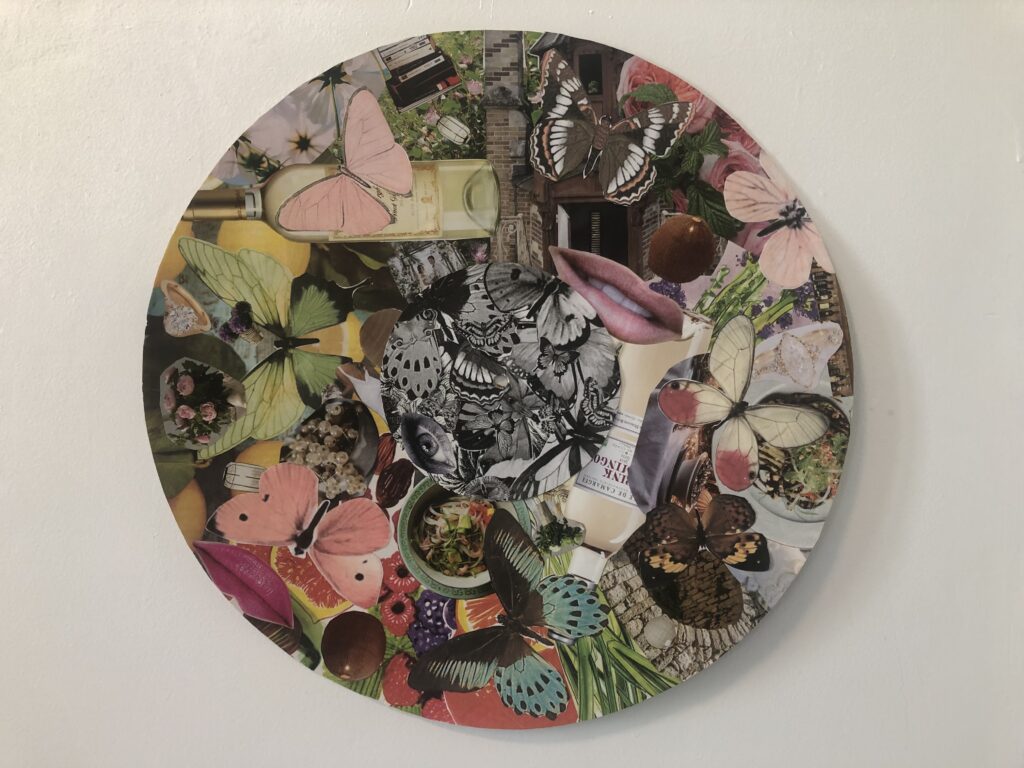
and Elke von Popper wedding.
back
Marriage: A Nexus between Social Strata
Firstly, the wedding appears as the beginning of Mosze-Thomas to a certain notoriety, as he later goes on to run a lucrative business, and becomes a Freemason, which gives him a particular access to important people and resources, for instance, when he is able to loan money to Jacob by means of a small bank he and other Freemasons set up. His character playing an important part in the book, we thought it was interesting to represent an event of his life also as he embodies the social mobility so desired by Jacob Frank.
Furthermore, this part is not only relevant when looking at Mosze-Thomas’ life but also when exploring Eva’s. Indeed, the young woman is still at the center of this extract even though it tells the story of her cousin’s wedding. By having her memory interrupt the narrative of the wedding, the readers are reminded of her character and the crucial role she has in the story. In a sense, this extract gives us a glimpse of Eva’s life: followed by memories, and the ones of her mother, she has to do what her father says (in this extract, he chooses who she is allowed to dance with; in the memory she has, she is forced to wear clothes chosen by her father) while still wanting a normal life, where she can be her own person (as one can analyze her spending time with her cousins, dancing, drinking wine sneakily). Following this importance of Eva, the extract also illustrates Jacob’s power, over his daughter but also over the community, as he is a very influential and known man. As seen at a moment in the book, him sitting in the shadows, surrounded by women gives us the impression that even when he is not in the spotlight, his presence is still very significant.
back
A Vinyl: The Spinning Cycle of Life
Our map covers a wide range of ideas and themes from the section on the wedding between Mosze Dobruszka, also known as Thomas von Schönfeld, and Elke von Popper in the chapter, all put together collage style.
Firstly, the shape and form of our map represents a vinyl which we imagined being a unique way to explore the musical aspect of weddings, and also of the time period of the book. We also chose not to specify any music to allow the reader to imagine it. We wanted to highlight the vinyl as a vehicle of the music per se since music is a large part of wedding celebrations and the circularity of the vinyl represents the circle of life and how life is constantly progressing and moving on. Through the way a vinyl works from outside to inside of the circle, one can also grasp the interest behind this extract: music is played as long as the diamond runs on the colorful part (wedding), but when it gets to the middle (Eva’s memory), the music stops. Such as life stopped, as her mother whom she remembers in the extract, music stops when the diamond gets to the middle. The vinyl, though not a technology created yet at that time, is a way for us to represent the modernity of the book. Indeed, the topics of Tokarczuk’s book are still relevant in our times, as they were in the last decades: religion, migration and travels, power.
A spiral groove running along the surface of each side also represents a kind of trajectory. But what happens when someone doesn’t follow the predetermined groove? Both parts—one in black and white and the other in color – provide elements of an answer. While the black-and-white center represents, as we shall see, the memories of Eva’s past life, more chaotic and less organized (the center of a vinyl is not grooved and allows free movement), the colored part depicts a bourgeois life in society, well-ordered and adhering to well-defined patterns, much like the grooves typically found in this part of the vinyl.
This object is thus both a representation of the music and its omnipresence and of the modernity of the sixth book. The use of the shape of the vinyl for the cartography allows us to represent the Earth. Indeed, even though the Earth is not flat, it is round, such as our vinyl. Through the vinyl turning, and therefore the Earth turning, one can see migrations and Jacob’s travels through Europe, the Tokarczuk’s book’s subtitle being A fantastic journey across seven borders, five languages and three major religions, not counting the minor sects. Furthermore, as the wedding takes place in a closed space—the gardens rented—it is hard to project the cartography outside the limits of the gardens. Therefore, we decided to have a finite space. Finally, the cartographic vinyl is bigger than a regular one. This element allows us to represent Jacob as a bigger than life character. Jacob lives his life by his own means and his own rules, putting what pleases him above all. He goes beyond societal norms, helping us give him this title of bigger than life.
back
Intersecting Memories
The middle portion of the vinyl represents Eva’s memories during the wedding celebration. This portion of the cartography is in black and white to demonstrate how our memories can sometimes be seen in black and white for many people as the time that has elapsed since these events happened tends to leave out certain information and key aspects. The black and white also represents a sadness to Eva’s memories: “This reminds Eva Frank of herself when she was Esther’s age—fifteen —in the dark grey dress her father made her wear in Częstochowa so she wouldn’t attract the soldiers’ attention.”37 Indeed, she remembers the dress that her father made her wear to make her less attractive to the male soldiers when she was living with him in the Czestochowa monastery where he was imprisoned after his conversion to Catholicism. She also feels a sadness remembering and yearning for her mother. This section of our cartography includes many photos of butterflies. This comes from when Esther Dobruszka told Eva that she is a butterfly: “‘You are a butterfly, too,’ Esther, the youngest Dobruszka child, says to Eva. This bit of praise lodges in Eva’s memory, and she thinks about it for a long time after.”38 It leads to Eva pondering on that, leading her down a rabbit hole of sad memories of her childhood.
We also included a black and white photo of an eye, which represents the eyes of the soldiers that Jacob was trying to have not look at his daughter in a sexual way, as mentioned before when he gave Eva the conservative dress to wear. The eye is also a way to represent Jacob always looking over his daughter and her life. In the extract but also throughout the book, Jacob looks at his daughter, her actions, her words, and his input on how to live her life are more imposed than suggested. This portion of the cartography being in the middle also represents how Eva feels trapped in her life, constantly being controlled by her own father. Her sadness and memories are being surrounded by the happiness of others and the celebrations of the wedding party, something that feels unobtainable for her in her future. Eva represented in the middle also is a way to represent her feelings for Mosze-Thomas. Indeed, it is mentioned earlier in the sixth book, that when Eva met Mosze-Thomas she felt drawn and attracted to him. Being there, at his wedding, dancing with men that don’t attract her could be seen and lived as a form of entrapment.
The outer part of the vinyl cartography represents the celebrations taking place at the wedding. We included photos of more butterflies, not only because they were in Eva’s memories but also because they were on display at the wedding. Butterflies are a symbol of growing up and becoming an adult. One can see Mosze-Thomas’s wedding as him becoming an adult: “Mosze will become Thomas von Schönfeld;” he is gaining a noble last name, but also his independence. We also included photographs of food, table set-ups, wine, lanterns, and flowers because they were part of the decorations at the wedding and show the happiness that weddings bring as “Aside from the magnificence of the tables, which hold food and enormous bouquets of May flowers, the main attraction is the pavilion, where there is an extraordinary collection of butterflies on display.”39 A reader could also discover “In the evening, when the lanterns are lit in the garden, she [Eva] stands in a group, a little tipsy from the wine...”40
back
Symbolizing Colors of Celebration
The mix of colors is moreover a way to represent such happiness. There is not one prominent color in this part, however, some are more present: green, yellow and pink. The green represents nature as, described in the vibrantly imagistic extract, the wedding took place in spring in gardens. The yellow is a way for us happiness and positivity, as well as the sun and light. This element has a double-meaning, sun and light for the month of May, when the wedding takes place, and sun and light that Jacob seems to bring to his followers. Through pink, we aimed at representing love, immaturity and playfulness which represent Eva. Undeniably, the young woman has romantic feelings towards Mosze-Thomas, but other men also express such feelings towards Eva. As for the mouths included in the cartography, they represent the discussions and the tools used to drink the wine. Finally, photographs of wedding rings and other wedding-related photos were included to add to the overall theme of the wedding that this cartography revolves around. The vibrant colors used in the outer ring represent the happiness and vibrance that weddings bring to the guests and families and help to enhance the difference of moods between Eva’s memories in the middle and the celebratory outer ring.
This project was a great way to uniquely explore the musical and artistic side of the sixth book from The Books of Jacob. Through different challenges while creating the cartography, we are proud to have completed it with deep and hidden messages within it. The sixth book challenged us, with its complex topics that we were not very familiar with. Creating this cartography helped us to understand this different period of time and the stories of Jacob Frank.
back
* This article was translated by Clara Leon-Brown and uses experimental didactics.
1 Piera Rossetto and Ewa Tartakowsky, eds., In other words: Opening research to Creative Practices (to be published in 2025).
2 Ewa Tartakowsky, “Transmettre en étudiant les objets. Une expérience d’enseignement par la bande dessinée,” Matériaux pour l'histoire de notre temps 1-2, no. 147-148 (2023): 45-51; 45-46.
3 All quotes of my students’ contributions refer to the following edition: Olga Tokarczuk, The Books of Jacob, or A Fantastic Journey Across Seven Borders, Five Languages and Three Major Religions, Not Counting the Minor Sects. Told by the Dead, Supplemented by the Author, Drawing from a Range of Books and Aided by Imagination, the which Being the Greatest Natural Gift of Any Person. That the Wise Might Have It for a Record, that My Compatriots Reflect, Laypersons Gain some Understanding and Melancholy Souls Obtain Some Slight Enjoyment, trans. Jennifer Croft (London: Fitzcarraldo Editions, 2021).
4 For one example, the workshop “C’est pas très académique!” (“It’s Not Very Academic”) as organized by Agnès Villechaise and Morgane Jouaret at the Centre Émile Durkheim (UMR 5116) in Bordeaux (https://www.centreemiledurkheim.fr/les-ateliers-de-recherche/atelier-cest-pas-tres-academique/), the ThermoDanse project, as conceived by the physicist Morgan Chabanon as well as Namiko Gahier and Cosetta Graffione, dancers and choreographers, at the CentraleSupelec and the ENS Saclay, which seeks to understand, modelized and express one’s physicality using one’s body (https://www.youtube.com/watch?v=yghHIkjq5N4). Last accessed December 23, 2024.
5 Tokarczuk, The Books of Jacob, 883.
6 Ibid., 871.
7 Ibid., 27.
8 Ibid., 876.
9 Ibid., 39-38.
10 Ibid., 794.
11 Ibid.
12 Ibid.
13 Ibid., 808.
14 Ibid., 792.
15 Ibid., 790.
16 Ibid., 811.
17 Ibid., 794.
18 Ibid., 785-784.
19 Ibid., 642.
20 Ibid., 635
21 Ibid., 593.
22 Ibid., 591-590.
23 Ibid., 621-620.
24 Ibid., 600.
25 Ibid., 593.
26 Ibid., 500.
27 Ibid., 465.
28 Ibid., 466.
29 Ibid., 465.
30 Ibid., 259-258.
31 Ibid., 275-274.
32 Ibid., 284.
33 Ibid., 242-241.
34 Ibid., 299.
35 Ibid., 296.
36 Ibid., 314.
37 Ibid., 192.
38 Ibid., 193-192.
39 Ibid., 193.
40 Ibid., 192.
Ewa Tartakowsky is a sociologist and researcher at the French National Center for Scientific Research (CNRS) within the Institute of Social Sciences of Politics (UMR 7220). She is also affiliated with the Centre of French Civilization and Francophone Studies at Warsaw University as an associated researcher and teaches at Sciences Po Paris. Her research focuses on contemporary Jewishness, exploring the reception and production of literary works, the transmission and social uses of the past, memory patrimonialization, and the teaching of history. She has notably studied French writers of Jewish-Maghreb origin within the context of post-colonial France. Her current work examines the transmission of Jewish history in Poland since 1989. Tartakowsky is the author of Les Juifs et le Maghreb: Fonctions sociales d’une littérature d’exil (PUFR, 2016) and has co-edited several works on contemporary Jewishness, including Juifs d’Europe: Identités plurielles et mixité (PUFR, 2017) and Between Memory and Everyday Life: Jewish Europe Today(Austeria, 2020).